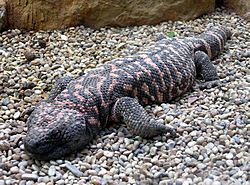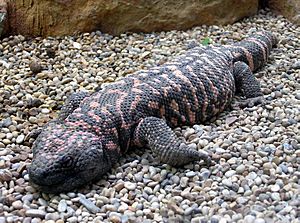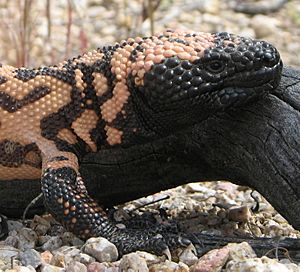Gila monster facts for kids
Quick facts for kids Gila Monster |
|
|---|---|
 |
|
| Conservation status | |
| Scientific classification | |
| Kingdom: | |
| Phylum: | |
| Class: | |
| Order: | |
| Family: |
Helodermatidae
|
| Genus: |
Heloderma
|
| Species: |
H. suspectum
|
| Binomial name | |
| Heloderma suspectum |
|
The Gila monster (pronounced hee-la) is a venomous desert lizard. It gets its name from the Gila River in Arizona, USA.
Gila monsters are heavy and slow for a lizard. They can grow up to 2 feet (60 cm) long. Their skin looks like beads and comes in colors like black, pink, orange, and yellow. They look a lot like the Mexican beaded lizard, which is their closest relative.
A Gila monster can bite quickly and hold on tightly. However, their bite is not usually deadly to humans. They typically eat small rodents, young birds, and eggs. The lizard chews its prey, injecting its venom (poison) into the animal through teeth in its lower jaw. The Gila monster can also store food in its tail.
In 2005, a medicine to treat diabetes was made from the Gila monster’s saliva. Some people who take it jokingly call it "lizard spit."
Contents
What is a Gila Monster?
The Gila monster is the largest native lizard in North America north of the Mexican border. It can be from 26 to 36 cm (10 to 14 in) long from its snout to its bottom. Its tail adds about 20% to its body size. The largest Gila monsters can reach 51 to 56 cm (20 to 22 in) in total length.
Most Gila monsters weigh between 350 to 700 grams (0.77 to 1.54 lb). Some very large ones can weigh as much as 2300 grams (5.1 lb).
Where Does its Name Come From?
The name "Gila" comes from the Gila River Basin. This area is in the U.S. states of New Mexico and Arizona. Gila monsters used to be very common there.
The scientific name Heloderma means "studded skin." This comes from ancient Greek words: helos (meaning "the head of a nail or stud") and derma (meaning "skin"). The word suspectum was chosen by the scientist Edward Drinker Cope. He suspected the lizard was venomous because of the grooves he saw in its teeth.
Gila Monster Family Tree
The Gila monster has one close living relative, the beaded lizard (H. horridum). They also have many relatives that are now extinct. These ancient relatives lived as far back as the Cretaceous period.
The group of lizards called Heloderma has been around since the Miocene era. Scientists have found pieces of Gila monster bones from about 10,000 to 8,000 years ago. Because these lizards have not changed much over time, some people call them "living fossils."
Even though Gila monsters look similar to monitor lizards from other parts of the world, they are placed in their own special family. This is because they have unique features not found in monitor lizards.
Where Do Gila Monsters Live?
Gila monsters live in the Southwestern United States and Mexico. Their home range includes Sonora, Arizona, and parts of California, Nevada, Utah, and New Mexico. They might also live in Baja California.
They prefer scrubland, desert areas with succulent plants, and oak woodlands. They like places where they can easily find moisture. Gila monsters often hide in burrows, thick bushes, or under rocks. They seem to enjoy water and will sometimes soak themselves in puddles after a summer rain. They avoid open areas like flat fields or farms.
Daily Life of a Gila Monster
Gila monsters spend most of their time, about 90%, underground. They stay hidden in burrows or rocky shelters. They are usually active in the morning during the dry season (spring and early summer). Later in the summer, they might come out on warm nights or after a thunderstorm.
Their body temperature stays around 30°C (86°F) when they are on the surface. Gila monsters are not fast runners. However, they can keep going for a long time and have good endurance for a lizard. Coyotes and raptors (birds of prey) sometimes hunt Gila monsters.
What Do Gila Monsters Eat?
Gila monsters eat small birds, mammals, frogs, lizards, insects, and carrion (dead animals). They mostly eat bird and reptile eggs. They do not eat very often, maybe only five to ten times a year in the wild. But when they do eat, they can eat a lot—up to one-third of their own body weight!
They use their amazing sense of smell to find food, especially eggs. Their smell is so good that they can find and dig up chicken eggs buried 15 cm (6 in) deep. They can even follow a trail made by a rolling egg.
If their prey is large, they might crush it to death. If it's small, they swallow it whole, head-first. They use strong muscles in their neck to help push the food down. After eating, Gila monsters quickly start flicking their tongues again to search for more food. This is probably because they often find many eggs or young animals together in nests. Gila monsters can also climb trees and cacti to find eggs.
Gila Monster Life Cycle

Gila monsters come out of hibernation in January or February. They mate in May and June. The male starts by flicking his tongue to find the female's scent. If a female does not want to mate, she will bite the male and crawl away.
The female lays her eggs in July or August. She buries them about 5 inches (13 cm) deep in the sand. A female usually lays between two and 12 eggs, with five being the average. The eggs hatch after about nine months. The baby Gila monsters come out in April through June of the next year.
Hatchlings are about 16 cm (6.3 in) long. They can bite and inject venom right after they hatch! Young Gila monsters often have more pink bands on their scales than adults. Gila monsters become adults and can have their own babies when they are three to five years old.
After laying eggs, adult Gila monsters spend less time above ground. This helps them avoid the hottest parts of the summer. They usually start their hibernation around November.
Not much is known about how Gila monsters interact with each other. However, males have been seen fighting each other. The stronger male will lie on top of the weaker one and pin it down. Both lizards will arch their bodies, push against each other, and twist around to try and get the top position. A fight ends when they are forced to separate. These fights usually happen just before mating season.
Gila Monsters and Medicine
In 2005, a medicine called exenatide (sold as Byetta) was approved in the US. It helps people manage type 2 diabetes. This medicine is a made-up version of a protein called exendin-4. This protein comes from the Gila monster's saliva.
The lizard protein works because it is very similar to a human hormone called glucagon-like peptide-1 (GLP-1). This hormone helps control insulin and glucagon in the body. The lizard protein stays active much longer than the human hormone. This helps people with diabetes keep their blood sugar levels steady. Exenatide also slows down how fast the stomach empties and can make people feel less hungry. This can help with weight loss.
The saliva of the Gila monster has many chemicals, some of which can be dangerous. One of these chemicals has been shown to affect memory. Several companies are studying this chemical to see if it can help with memory loss. This includes memory problems from diseases like Alzheimer’s disease, schizophrenia, and ADHD.
A substance called Gilatide, which comes from exendin-4, has been shown to greatly improve memory in studies with mice. Scientists will likely continue to research Gilatide to help patients with Alzheimer’s disease.
Images for kids
See also
 In Spanish: Monstruo de Gila para niños
In Spanish: Monstruo de Gila para niños


















